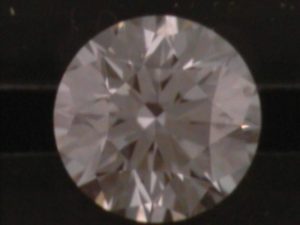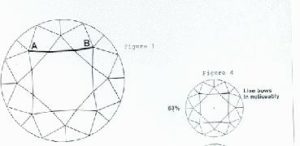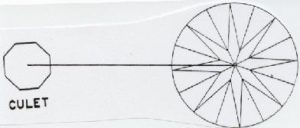Certain modern round brilliant cut diamonds are cut to within certain tolerances that allow them to be referred to as ‘ideal’ cut. Why is reference made to the ideal cut when judging the proportions of a round brilliant cut diamond? The reason is that it displays the most suitable balanced display of brilliancy and fire, and it is the styled of modern brilliant cutting that retains the least weight from the average rough diamond. ‘Fire’ refers to the flashes of the different spectrum colors seen in diamonds as a result of the diamond separating white light into the spectrum colors as the light leaves the angled crown facets after being totally internally reflected in the diamond. ‘Brilliancy’ in the diamond is the amount of light reaching the eye as a result of reflections from the internal surfaces of facets, called total internal reflections, and reflections from the external surfaces of the table and other facets of the diamond. GIA STANDARDS FOR THE IDEAL CUT For a diamond to be considered ‘ideal’ the GIA has set certain standards. Depth: 58.3 to 62.9%
Table Size 53 to 60%
Girdle: Medium to slightly thick
Pavilion Depth: 43%
Polish: Good to Excellent
Symmetry: Good to Excellent
Culet: none to medium
The above cut guidelines apply for diamonds 0.50cts. and up. For smaller sizes slightly larger tables up to 62% are acceptable.
AGS STANDARDS FOR THE IDEAL CUT The AGS considers the following proportion parameters when determining whether or not a diamond falls into the ‘ideal proportions’. Table diameter: 53% – 57.5%
Girdle: Thin, medium, slightly thick
Pavilion Depth: 42.5%-43.5%
Culet: Pointed, very small, small, medium
Both the GIA and the AGS have similar grading standards. There are other cut classifications such as ‘very good’ or ‘good’ and the diamond HAS JUST AS MUCH BRILLIANCE as an ideal cut diamond. Call 1-800-252-1476 so I can obtain the best cut diamond at the absolute lowest rockbottom price. I will not compromise on the cut at all. Yes, there are certain distinguishing characteristics that IDEAL cuts have. Firstly, on an ‘ideal cut’ if you look directly down and straight into the table of the diamond with a 10X loupe you will notice a certain phenomenon. Focus towards the bottom point of the diamond (the culet) and you should notice a small octagonal formation around the culet. This is the table reflection that is produced by the ‘ideal cut’. It should cover about 1/3 of the table diameter. You will notice that effect in the following 2 ideal cut diamonds displayed below. 
With ideal cuts, you will notice a bowing in of the facet lines as illustrated in the following sketch. If you look at the sketch and then compare to the actual photos you will then see the effect very clearly. The Polish of an Ideal Cut Diamond 
With an ‘ideal’ cut diamond the polish should be rated as good, very good or excellent on the GIA cert or have a ‘0’ rating on the AGS cert.
To achieve maximum brilliancy in a diamond it is essential that the facets be flat, planar surfaces. Hasty and careless polishing can leave wheel marks that affect brilliancy and luster. These wheelmarks are seldom visible to the unaided eye. The wheel marks cause the surface to be very minutely grooved, and in turn these minute grooves caused diffusion of the light that is transmitted through and reflected from the diamond.
A well polished diamond will show no evidence of wheel marks under 10X. Wheel marks can easily reduce the brilliancy of a diamond to below its optimum beauty. THE GIRDLE OF THE DIAMOND The girdle of an ideal cut diamond can range from thin to slightly thick. This applies to both GIA and AGS certed diamonds. Avoid diamonds with extremely thin or thick girdles. 
A well finished girdle surface is one that is so smooth that it is waxy rather than dull. If a diamond is rounded up too quickly in the fashioning process, the result will be a fuzzy appearing girdle that may be rough. A rough girdle may make a diamond appear greyer or darker when viewed face up. This would be caused by oil or dirt becoming embedded in the girdle surface. A girdle may be faceted or polished and this has no effect on the value of the diamond. | THE CULET OF THE DIAMOND The culet should appear as a tiny polished facet at the tip of the pavilion. Should the culet be chipped or abraded, this will detract from the diamond’s appearance. If the culet is rough or unpolished, it will appear as a frosty white dot.
In an ideal cut diamond, the culet should be either pointed, very small, small or medium. 
| THE SYMMETRY OF THE DIAMOND Symmetry discrepancies should not be visible under 10X if a diamond is to be considered ideally cut. The table must conform to the ideal octagonal shape. The facets should all meet at a point and if they fail to do so they would be misshapen as a result. When a diamond is graded for symmetry, the following 9 features are taken into account. 1. Table or culet slightly off centre.
2. Unequal sizes of opposing facets.
3. Misshapen facets.
4. Table not octagonal
5. Girdle outline slightly out of round
6. Table not parallel to girdle.
7. Facets fail to point up.
8. Pavilion and crown main facets out of alignment.
A SPECIAL NOTE
Ideal cut diamonds have a very high degree of brilliance. However, the majority of modern round brilliant cut diamonds are not ‘ideal’ but still have overall ‘good’ cut grades. THESE ‘GOOD’ CUT DIAMONDS WILL STILL HAVE IN MANY CASES AN EQUAL BRILLIANCE TO THE IDEAL CUT DIAMOND.
THEREFORE, UNDER NORMAL CIRCUMSTANCES YOU WILL NOT BE SENT ANY CERTS ON ANY DIAMONDS WHERE THE FOLLOWING CRITERIA ARE NOT MET: A. The depth percentage WILL NOT exceed 63%. And will not be less than 58%
B. The table will not exceed 63%.
C. The girdle will be in the range from thin to thick.
D. The polish and symmetry can never be lower than ‘Good’.
Please call Colin Sheffield (647) 984-4100 for immediate assistance in selecting the diamond that is perfect for you. Or, go to the cert search section and fill in the details in the chart pull down section or just email me below with all the details of what you have in mind: |
| 



